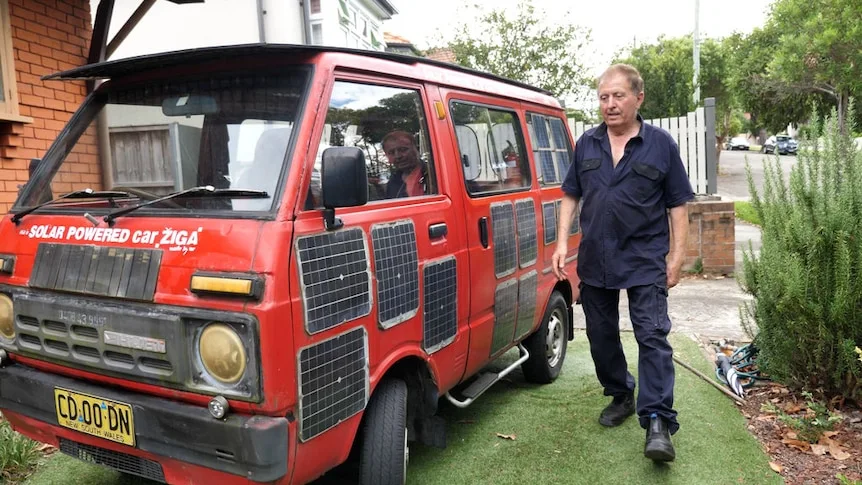Thought of you fine folks when I came across this article on aussie.zone
I was going to say this sounds like thermal runaway waiting to happen, but apparently it’s been running for 10 years so clearly he knows what he’s doing
I feel like the PV panels on the side are just gratuitous. Can’t imagine they’d contribute much, right?
“When it’s not plugged into the home the van’s batteries are being charged by a 1-kilowatt panel on its roof and small panels on the sides which charge the indicators and lights.”
Must’ve missed that part. Thanks!
I could see them adding a significant charge in morning/late afternoon when the sun is low. Im dont actually know though lol
You’re correct. Only the roof is likely to give significant power. Been there and done that, on the opposite side of the planet though. :)
The “something” on the picture I attach… was built in some squat in Eastern Europe. It had a flat roof of approximately 2 x 1.5 m, all of it solar panel. Solar panels weren’t great back then. Typically it charged its 4 KWh battery in a few days of sunshine. Only during midsummer (18-hour days) was there any chance of a full charge in a single day.

Unlike the van, the “something” required a smaller inventory of tools to build. Instead of lawnmower motors, a Chinese electric motorcycle motor was used. Sadly it’s now retired due to metal fatigue. :( Lesson: never build a structure that flexes out of aluminum - aluminum has no fatigue limit, any flexing will lead to cracking.
Sadly laptops don’t use these standard battery types anymore, but I guess powertool batteries still work as a source for recycling them.
three 10-horsepower electric motors from ride-on lawn mowers.
Oh I thought he had ICE lawmower motors for some kind of hybrid engine.
If you only have a small regular commute like 5-20 km for work or shopping you really only need a tiny electric car and battery.
I would have loved to have / build something like this but in my well regulated european country it’s near impossible to get this street legal certification. A mobile home / caravan with 12m² of roof space and 6 kWh of solar panels.
Instead I want to build a solar powered boat. You don’t need to move so fast and can have roof surface area and you can travel the world without moving. It’s not exactly easier than converting a car though lol.
I would have loved to have / build something like this but in my well regulated european country it’s near impossible to get this street legal certification.
Yep. :( The certification manual here, in a moderately regulated European country, is about 250 pages long. Fortunately, not all chapters apply to moped-cars. If one really really wants, moped-cars are the way to break through the barrier.
Something like “L7e”? There are some European classiciations that are theoretically pretty interesting. But you still have to get certified parts, like motor without electric noise and batteries and controller and (I think) still have to test them together in a certified expensive lab. Also windshields.
I wish we had a constitution that costs arising from bureaucratic regulations always have to be paid by the state and never by the citizen. That would fix regulations real quick :D
Yep. I’ve done an L2e, and some day I will manage an L7e. :)
Interference testing was not needed. The motor wattage and motor controller wattage labels were examined. I could have dropped in more power in a mood for forgery, but I was in an honest mood. :)
Oh wow very nice, congrats!
I want to build a tadpole recumbent / cargo bike for shopping, then maybe a quadricycle and a velomobile with motor for pedelec. I wish they’d allow pedelec up to 50km/h instead of 25 without needed certification and insurance. That’d be a huge boost for the environment. But even the L1e with 45km/h seems purposefully gimped for city traffic to protect car manufacturers.
But a proper “recumbent motorcycle” that can go 100km/h with 3 or 4 wheels and is ultra lightweight would be awesome too.
Myself, I went for 45 km/h officially (unoffially, on a flat road, I could reach 53 km/h). While turning, for safety reasons, I limited myself to far lower speeds (25 km/h).
Designing a car suspension system for reasonably high speed seems hard, I have never tried, instead choosing the robust and crude solutions to get a reasonable assurance of strength.
Motorcycles seem easier. Especially since most of factory-made motorcycles use a sprocket and chain - a very flexible system for dropping in other power sources. I imagine that with enough know-how to get through type certification, a lot of combustion bikes could become e-bikes with excellent riding characteristics. :)
lawnmower engines??
It seems like he used the engines of electric “raiders” (ride-on lawnmowers, that is - small tractors). I cannot fathom why and how he used 3, but the tools in his shed suggest he can build anything. That’s one impressive shed.





